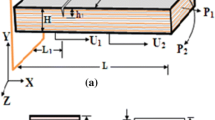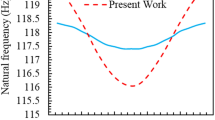Abstract
Purpose
In the present investigation, vibration signatures have been used for identifying the place of crack and depth in pre-cracked FRP beams. Bidirectional (woven) FRP composite beams are consisting of 13 layers of epoxy–glass fibres (0°/7.5°/15°/22.5°/30°/37.5°/45°). Effects of clamped–free and clamped–clamped end conditions have been studied in the current investigation.
Methods
Fibre orientations effect on dynamics of FRP beam by the altering transverse crack location and its depth have been observed by applying analytical, finite element method, and neural network techniques.
Results
The results obtained have been verified experimentally. The outcomes of both methods have deviation within 6% during comparison.
Conclusion
From the investigation, it has been concluded that the natural frequencies and mode shapes can be used for identifying crack location and crack depth for different fibre orientation in FRP beam.











Similar content being viewed by others
Abbreviations
- A:
-
Cross-sectional area of the of FRP beam
- C-F:
-
Clamp–free end condition
- Cij :
-
Flexibility influence matrix
- E:
-
Modulus of elasticity of the FRP beam material
- FRP:
-
Fibre-reinforced plastic composite
- F i (i = 1, 2):
-
Function determined experimentally
- H :
-
Thickness of the beam
- h 1 :
-
Pre-crack depth
- I :
-
Moment of inertia
- i, j :
-
Variables
- J C :
-
Release rate of strain energy
- K Ii (i = 1, 2):
-
Intensity factor of stress used for Pi load
- K ij :
-
Local flexible element matrix
- L :
-
Length of the FRP beam
- L 1 :
-
Crack locale in FRP beam from one end
- M i (i = 1, 4):
-
Compliance constant
- P i (i = 1, 2):
-
Pi = axial force (i = 1) and Pj = bending load (i = 2)
- K :
-
Stiffness matrix
- u i (i = 1, 2):
-
Additional displacement functions
- U c :
-
Strain energy caused by pre-crack
- W :
-
FRP beam breadth
- X, Y, and Z :
-
Reference co-ordinate for FRP beam
- Y 0 :
-
Exciting vibration amplitude
- y i (i = 1, 2):
-
Standard function (transverse) yi(x)
- ω n :
-
Natural frequency of un-cracked FRP composite beam (NFUCB)
- ω c :
-
Frequency of cracked FRP composite beam (FCCB)
- ∆ω :
-
(ωn) − (ωc)
- (∆ω/ω n):
-
Relative eigen frequency (REF)
- (ω c/ω n):
-
Relative natural frequency (RNF)
- χ :
-
Relative crack depth (RCD = \(\frac{{h_{1} }}{H}\))
- \(\psi\) :
-
Relative crack location (RCL = L1/L)
- \(\rho_{\text{C}}\) :
-
FRP composite beam mass density
- \(\delta \,\) :
-
Constant of characteristic equation
- \(\varUpsilon\) :
-
Coefficient of independent force
- \(g\) :
-
Complex constants
References
ANSYS, released version 13, user manual
Altun F, Dirikgil T (2013) The prediction of prismatic beam behaviors with polypropylene fiber addition under high temperature effect through ANN, ANFIS and fuzzy genetic models. Compos Part B Eng 52:362–371
Cao M, Radzieński M, Xu W, Ostachowicz W (2014) Identification of multiple damage in beams based on robust curvature mode shapes. Mech Syst Sig Process 46:468–480
Dash AK, Parhi DR (2011) A vibration based inverse hybrid intelligent method for structural health monitoring. Int J Mech Mater Eng 6(2):212–230
Fang X, Luo H, Tang J (2005) Structural damage detection using neural network with learning rate improvement. Comput Struct 83(25–26):2150–2161
Ghoneam SM (1995) Dynamic analysis of open cracked laminated composite. Compos Struct 32:3–11
Hagan MT, Demuth HB (1996) Neural network design, 1996. PWS publishing Company, a division of Thomson Learning, Boston
Jones RM (1999) Mechanics of composite materials, 2nd edn. Taylor and Francis, New York
Knibbs RH, Morris JB (1974) The effects of fiber orientation on the physical properties of composites. Composite 5:209–218
Maiti A, Majumdar DK, Maity D (2012) Damage assessment of truss structures from changes in natural frequencies using ant colony optimization. Appl Math Comput 218:9759–9772
Nikpur K, Dimarogonas A (1988) Local of compliance of composite cracked bodies. Compos Sci Technol 32:209–223
Nguyen SD, Ngo KN, Tran QT, Choi SB (2013) A new method for beam-damage-diagnosis using adaptive fuzzy neural structure and wavelet analysis. Mech Syst Sig Process 39:181–194
Rafiee J, Tse PW, Harifi A, Sadeghi MH (2009) A novel technique for selecting mother wavelet function using an intelligent fault diagnosis system. Expert Syst Appl 36(3):4862–4875
Sekhar AS (2008) Multiple cracks effects and identification. Mech Syst Sig Process 22:845–878
Suresh S, Omkar SN, Ganguli R, Mani V (2004) Identification of crack location and depth in a cantilever beam using a modular neural network approach. Smart Mater Struct 13(4):907–915
Tada H, Paris PC, Irwin GR (1973) The stress analysis of cracks handbook. Del research Corporation, Hellertown
Vinson JR, Sierakowski RL (1991) Behaviour of structures composed of composite materials, 1st edn. Martinus Nijhoff, Dordrecht
Xue JN, Jiao XL, Xiao RY, Ji F (2012) Modal analysis of laminated composite beam based on elastic wave theory. Appl Mech Mater 151:275–280
Zheng SJ, Li ZQ, Wang HT (2011) A genetic fuzzy radial basis function neural network for structural health monitoring of composite laminated beams. Expert Syst Appl 38(9):11837–11842
Zhu F, Deng Z, Zhang J (2013) An integrated approach for structural damage identification using wavelet neuro-fuzzy model. Expert Syst Appl 40:7415–7427
Author information
Authors and Affiliations
Corresponding author
Additional information
Publisher's Note
Springer Nature remains neutral with regard to jurisdictional claims in published maps and institutional affiliations.
Rights and permissions
About this article
Cite this article
Jena, P.C., Parhi, D.R. & Pohit, G. Dynamic Investigation of FRP Cracked Beam Using Neural Network Technique. J. Vib. Eng. Technol. 7, 647–661 (2019). https://doi.org/10.1007/s42417-019-00158-5
Received:
Accepted:
Published:
Issue Date:
DOI: https://doi.org/10.1007/s42417-019-00158-5




